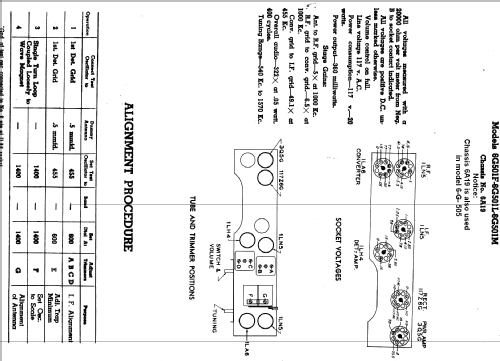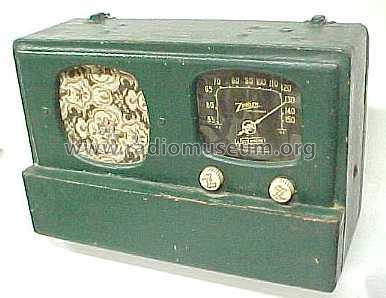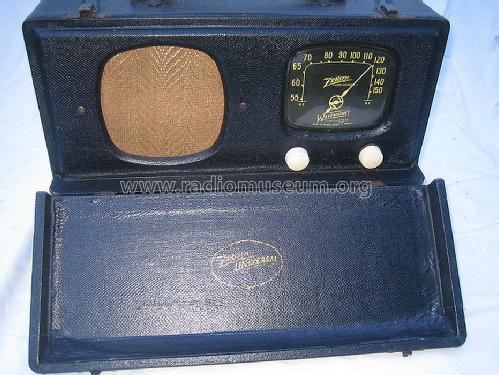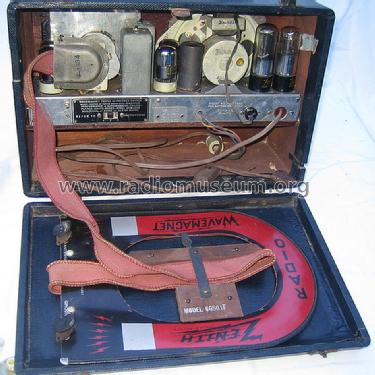6G501F Ch=6A19
Zenith Radio Corp.; Chicago, IL
- Pays
- Etats-Unis
- Fabricant / Marque
- Zenith Radio Corp.; Chicago, IL
- Année
- 1941
- Catégorie
- Radio - ou tuner d'après la guerre 1939-45
- Radiomuseum.org ID
- 67770
-
- alternative name: Chicago Radio Lab
Cliquez sur la vignette du schéma pour le demander en tant que document gratuit.
- No. de tubes
- 6
- Principe général
- Super hétérodyne avec étage HF; FI/IF 455 kHz
- Gammes d'ondes
- PO uniquement
- Tension / type courant
- Secteur et Piles (tous types). / 117; 90 & 9 Volt
- Haut-parleur
- HP dynamique à aimant permanent + bobine mobile / Ø 5.5 inch = 14 cm
- Matière
- Cuir / canvas / plastique mais autre matériel en dessous!
- De Radiomuseum.org
- Modèle: 6G501F Ch=6A19 - Zenith Radio Corp.; Chicago,
- Forme
- Portative > 20 cm (sans nécessité secteur)
- Dimensions (LHP)
- 381 x 249 x 178 mm / 15 x 9.8 x 7 inch
- Poids net
- 6 kg / 13 lb 3.5 oz (13.216 lb)
- Prix de mise sur le marché
- 29.95 USD
- Source extérieure
- Ernst Erb
- Source du schéma
- Rider's Perpetual, Volume 12 = ca. 1941 and before
- Littérature
- Guide to Old Radios
- D'autres Modèles
-
Vous pourrez trouver sous ce lien 4519 modèles d'appareils, 4111 avec des images et 3656 avec des schémas.
Tous les appareils de Zenith Radio Corp.; Chicago, IL
Contributions du forum pour ce modèle: Zenith Radio Corp.;: 6G501F Ch=6A19
Discussions: 1 | Publications: 7
Please be easy on me, this is my first radio post!
I have rebuilt a Zenith 6g501f. It functions perfectly on battery (actually quite outstanding), but on AC, it appears to have poor sensitivity to the point that the ACG runs the gain up and generates a lot of noise. There's no real hum and the power supply voltages look good - although the filament string voltage is noticeably lower on AC. The alignment also looks very good and the dial tracks remarkably well, far better than any of my transoceanics.
My first thought was that my wall voltage was low, but no, it's right between 116.5-117. The B+ looks good at 85-86V, the filament supply is around 7.9V. Checking the individual tube filaments, they are all around 1.35V (and ~2.8 on the 3q5g) which is very close to specification. I have fiddled with the power resistors and when I raise the filament to ~9 (essentially the same as on battery) it seems to get slightly better, but the required power resistors are down around 850 ohms (vice 1006 ohms per the schematic). I know from Transoceanics that the filament voltage can dramatically effect the performance but I am surprised that the standard voltages seem to result in such poor performance. I have tried several different sets of tubes, some NOS, with essentially no difference in the results. Does anyone in this august body have any better ideas?
Brett
Brett Buck, 06.Jan.11




